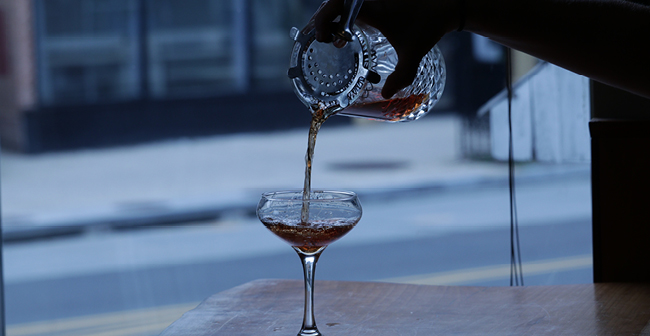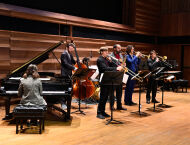Eat
 Photo: Courtesy of James P. Woods
Photo: Courtesy of James P. Woods
When Bourbon Is Your Entrée
September 5, 2017 @ 12:00am
The leaves are turning and school is starting, which means it’s National Bourbon Heritage Month (obviously). There is no better way to celebrate than by swapping out that overplayed bottle of rosé at dinner for a glass of the gorgeous golden dram. Sounds too disruptive? Only because you are not doing it right.
“With wine parings, it’s typically about the food first,” says James P. Woods, owner of Bourbon, a bar and restaurant in Adams Morgan. “With whiskey, it’s different. Whiskey is the entrée.”
Amen, James.
Still feeling tentative in your decision-making skills? Try these (very) loose guidelines around proof and age to get started.
If your favorite “entrée” is a younger, lower-proof bourbon (80 proof is the legal minimum), the lower alcohol content will allow it to share table space with more delicate favors like fish and shellfish, as well as cheese and fruits.
Move up to a slightly older (say, a seven to nine-year-old), 90ish-proof bourbon, and the flavors become more pronounced. In this range, pairings work best with seared poultry, smoked pork and game – as well as older and moldy cheeses, and robust fruits. Try apple pie, a slice of aged cheddar and a couple fingers of Wathen’s Kentucky Bourbon.
Once you start pouring an older, 100-proof bourbon, you’re in steak and chocolate territory, since those flavors have the cajones to play ball with the booziness and tannins in the glass.
Anything over 100 proof? That’s a standalone course – either the heat of the alcohol will be overwhelming, or it will be so divine that pairing would be sacrilege. If you have a 15-year-old Pappy, it deserves all your attention.
There is a creamy exception to the high-proof guidance: gelato, and very smelly cheeses. Fold a couple tablespoons of a non-divine bourbon into gelato; the tsunami of cold, creamy fat beloved by hipsters is able to cut into the fire of the booze and tease out its subtleties. And stinky-sock cheeses, like Époisses, are made more manageable by the hotness of the alcohol, mingling with the bourbon to create a strange umami high.
The next set of considerations involves the bourbon recipe, or mash bill. All bourbon is at least 51 percent corn (and it is usually closer to 70 percent). Along with corn, a little barley provides much-needed enzymes, and then a mix of wheat and rye determines the finished flavor profile.
This is what happens.
Rye forward: These are spicier, peppery bourbons – try Four Roses Single Barrel or Basil Hayden. The brightness of the pepper pairs well with heavier dishes involving beef or chocolate.
Wheat forward: Higher amounts of wheat result in softer, more approachable bourbons – think Maker’s Mark, or the much-coveted Pappy Van Winkle. Their smoothness contrasts nicely with spicier foods, such as mustard-based BBQ sauces.
These are very general guidelines. Ultimately, there is only one voice you need to heed.
“If you listen to the bourbon, it will tell you what it should be paired with,” instructs Torrence Swain, the head bartender at Bourbon Steak in Georgetown. “Bourbons with strong undertones of vanilla go really well with fruit, for example. You just have to put the same level of diligence into pairing bourbons as you do with wine.”
Cole Burger, the lead bartender at Blue Duck Tavern, agrees.
“Like red wine, it’s best to pair similar attributes when aligning bourbon with food,” he says.
Knowing your bourbon’s age, proof and mash bill is not enough. You need to sip it, commune with it, meditate on it. What flavors speak to you? What voices do you hear in your head? Many bourbons have an undertone of dried fruit, “like candied raisin or apricot,” notes Woods.
“With dried fruit, proteins are going to pair well,” Woods says. “Off the shelves at Bourbon, that might mean something like Woodford Double Oak or the Henry McKenna 10-Year.”
Meanwhile, for peppery and smoky bourbons, Burger directs Blue Duck Tavern diners toward the grill, while “the sweeter, more caramel-toned [bourbons] make a delightful dessert accompaniment.”
Dessert is a common theme. Woods says pairing whiskeys with dessert is his “favorite thing,” while Swain sends Bourbon Steak diners in a very specific direction.
“We have the Bourbon Chocolate Bar [brownie, caramel mousse, peanut butter] paired with a robust bourbon – we select a cognac-finished, nine-year-old, high-rye bourbon from DC’s own One Eight Distillery [“Untitled”] – and it is out of this world,” Swain says. “It’s like they’re holding hands.”
Does building your own bourbon-food pairings seem more alluring now, but still daunting? Then these are three places to start your adventures. Each has a fantastic bourbon collection presided over by wise bartenders to guide you in your decisions. Go forth and enjoy responsibly.
Blue Duck Tavern: 1201 24th St. NW, DC; www.blueducktavern.com
Bourbon: 2321 18th St. NW, DC; www.bourbondc.com
Bourbon Steak: 2800 Pennsylvania Ave. NW, DC; www.bourbonsteakdc.com







